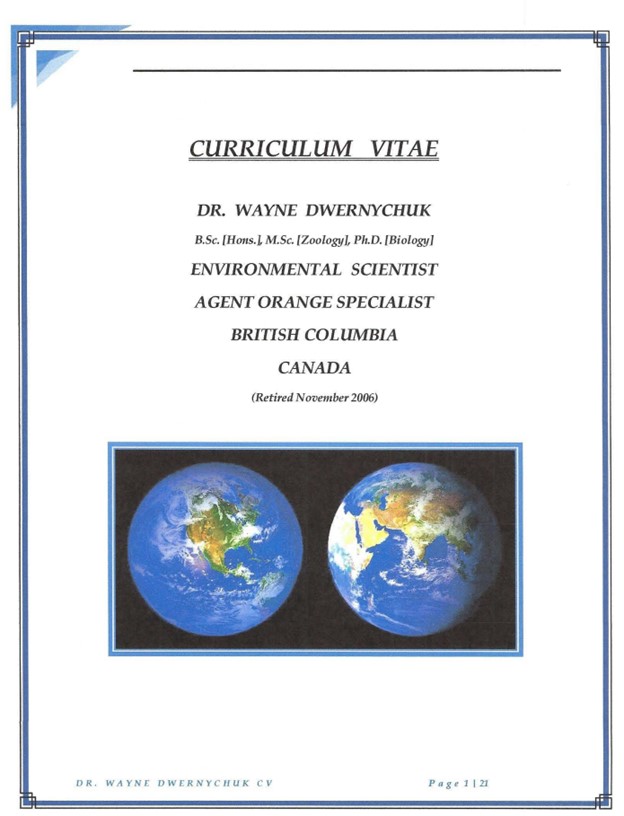For those who don’t know who Dr. Wayne Dwernychuk is, allow me to introduce his importance. Before I do, I want to thank Dr. Wayne Dwernychuk for sharing his knowledge and expertise as a Senior Environmentalist and Agent Orange expert, and for taking the time to answer my many emails and for his letter of support of my findings.You gave me great hope that I was on the right track to help my husband and many other Panama veterans who are suffering.
Once I found the same chemicals shipped to both Vietnam and Panama on the same U.S. Commerce document, I needed to know if what I found was the same and could be the cause of my husband and many other veterans’ diseases. I pulled up the Agent Orange Act of 1991, and it doesn’t say anything about “tactical herbicide” or “Agent Orange” except in the title of the bill. I wondered how can these same chemicals 2,4-D & 2,4,5-T be different depending on a painted orange stripe?
In 2017 I wrote to Hatfield Consultants to see if they could tell the difference. I received an email back from Dr. Wayne Dwernychuk regarding my findings and he agreed to edit my book and allowed me to quote him in my book “The Travels of Orange and other toxins.”
Dr. Wayne Dwernychuk, a world-renown Agent Orange expert, supported my research into the Panama Veteran. His opinion is:
"When considering the Vietnam situation there is the formula employed by the Department of Veterans Affairs called presumptive service. Presumptive illness/disability for a Vietnam veteran is determined by certifying that the individual served on the ground in Vietnam or on a ship in the South China Sea anytime between 1959 and 1975. Such a certification is made by reviewing the individual's military service records (usually the DD form 214 - individual's discharge from active service document). Once the veteran has a diagnosis of one of the disabilities or diseases included on the approved list in Title 38 (US Code), they file a claim for service-connected entitlements and the claim works its way through the VA (Veterans Affairs) process. The degree (percentage) of disability awarded by VA is based upon the veteran's health at the time of filing the claim. It is my contention that military personnel serving in areas where Agent Orange or 2,4,5-T was sprayed, and not limited to the Vietnam experience, could have been exposed to the dioxin component of these two categories of herbicide, TCDD. Consequently, the presumptive service nomenclature/formula should apply to these personnel."
Here is what Dr. Wayne Dwernychuk said in my book:
“Toxic chemicals referred to here may have been a 50/50 mixture of the herbicides 2,4-D and 2,4,5-T, otherwise commonly known as Agent Orange (AO), and/or 2,4,5-T in isolation from other herbicides. The term ‘Orange Herbicide’, as labelled by the U.S. military, was a 50/50 formulation of 2,4-D and 2,4,5-T to definite specifications of the US military. During the manufacture of 2,4,5-T, the toxic chemical 2,3,7,8-tetrachlorodibenzo-p-dioxin (TCDD) was generated and was initially an unknown toxin in this herbicide. By the mid 1970’s the presence of TCDD in 2,4,5-T was commonly known. However, there is evidence that TCDD was known as a by-product of the 2,4,5-T manufacturing process back to the mid 1960’s. Herbicides were also used for perimeter spraying and reducing vegetation along right of ways and roadsides in the PCZ. Table 2 titled Schedule B Commodity by Country Domestic/Merchandise (http://catalog.hathitrust.org/Record/000497548) clearly shows the transport and exportation of the herbicides 2,4-D and 2,4,5-T to Panama 1973-1977. It is unclear whether these two herbicides were, in fact, in an Agent Orange composition (as defined by US military specifications) as a shipping commodity, or they were shipped separately. They may have been mixed on site in the PCZ, or were, conceivably, applied separately. However, with respect to toxicological properties, it makes no matter whether these two herbicides were mixed or not. The very fact that 2,4,5-T was used is sufficient grounds to conclude that TCDD was applied wherever 2,4,5-T was used as a vegetation control agent. The TCDD content of the 2,4,5-T varied over time, but regardless, it was present in this herbicide and introduced to the PCZ environment. Unfortunately for service personnel, there were no attempts, to my knowledge, to ascertain the TCDD content of 2,4,5-T used in the PCZ or, for that matter, in PCZ soils or any other environmental media. TCDD in soil can remain a toxic component of the environment for over 100 years (Paustenbach, et al., 1992).”
Dr. Dwernychuk is the Agent Orange expert who is one of two people from Hatfield Consultants of Canada who went to Vietnam and tested and found dioxin, which tremendously helped the Vietnam Veterans in their battle for benefits. Witihout their findings, the Vietnam veterans would still be wondering. There are many hotspots found since in the world of dioxin use.
Unfortunately,Panama has not yet been recognized yet.
Here is Dr. Dwernychuk in Vietnam long ago, first testing for bombs before taking soil samples.

His full Curriculum Vitae was submitted as part of the Rulemaking Request by the Military-Veterans Advocacy put forward to the VA Secretary asking for Panama to be recognized. Please click on the first page of his CV below to take you to Dr. Dwernychuk’s CV.
